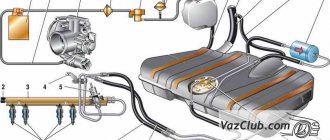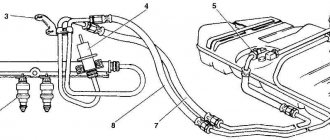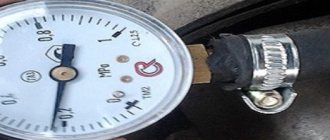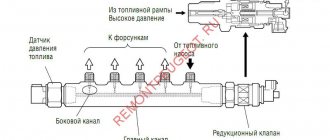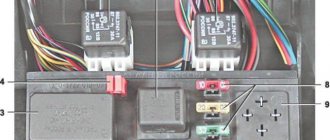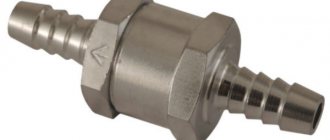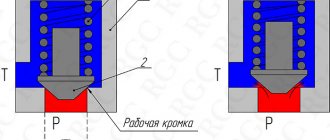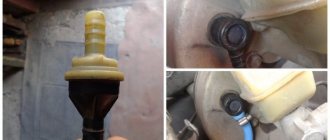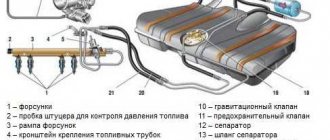How regulators work
The fuel rail is necessary to mix gasoline vapors and clean air. It maintains pressure at 2.9-3.3 kgf/sq. cm due to the pressure regulator. For injection, injectors with a solenoid valve are used. A regulator is connected to them, which is a valve made of a membrane. The device inlet is from the ramp side, the outlet is on the fuel drain line. A tube from the intake manifold is connected to the VAZ-2110 fuel pressure regulator.
The pressure is adjusted using a spring; its rigidity is selected so that it compresses only with a certain force. If the pressure of the fuel mixture in the rail exceeds 3.3 kgf/sq. cm, then the spring compresses, the valve opens and the excess is released into the return line. When the pressure reaches 2.9 kgf/sq. see the valve closes.
Types of faults
Among the most common device breakdowns are the following:
- The valve does not hold pressure - gasoline circulates freely throughout the entire line, including the return line. In this case, the pressure in the ramp decreases significantly, and it may not be constant. When you increase the engine speed, it begins to stall - there is not enough pressure to carry out normal injection. The amount of gasoline inside the ramp is very small. There is a noticeable decrease in power; it takes longer to start the engine than during normal operation. The electric fuel pump will run longer than usual.
- The valve does not work at all (does not open at maximum pressure) - the excess does not go into the tank. The pressure in the fuel rail is too high, significant excess consumption of gasoline occurs, and the cylinders are flooded. This malfunction of the fuel pressure regulator on the VAZ-2110 cannot be eliminated, so you only need to change the device completely.
Signs of breakdown
To independently identify a breakdown of the device, take a closer look at the operation of the engine. Typically the fault appears like this:
- The engine's operation is unstable, it shakes, and misfires are felt in the cylinders.
- When idling, the engine stalls.
- Acceleration is weak - throttle response is low, driving is difficult.
- There is a noticeable decrease in engine power; even at minimum load it feels “heavy”.
- The crankshaft rotates either at a low or high frequency. Sometimes the rotation speed varies over a wide range.
- Significant increase in gasoline consumption.
- Jerks and dips during uniform movement.
- Sometimes the breakdown manifests itself as difficulty starting the engine.
- Among the signs of a malfunction of the fuel pressure regulator on the VAZ-2110, one can highlight a significant excess of CH and CO content in the exhaust.
The last breakdown is detected only when diagnosing the engine using a gas analyzer.
Modifications of the VAZ-2112 car
VAZ-21120 . Modification with a 16-valve injection engine with a volume of 1.5 liters and a power of 93 horsepower. 14-inch wheels were installed on the car. This modification has a problem with valves bending when the timing belt breaks. The problem can be solved by increasing the depth of the grooves in the piston bottoms.
VAZ-21121 . The car was equipped with a VAZ-21114 8-valve injection engine with a volume of 1.6 liters and a power of 81 horsepower.
VAZ-21122 . Budget modification with an 8-valve injection engine VAZ-2111. The car was produced without electric windows, the wheels were 13 inches in size, and the brakes were unventilated from a VAZ-2108 car.
VAZ-21123 Coupe . Three-door, five-seater hatchback. The only two doors for entering the car are 200 millimeters wider than those of the five-door hatchback, and they are mounted on new, durable hinges. The rear arches of the car have become wider. The engine was installed with a 16-valve injection engine with a volume of 1.6 liters and a power of 90 horsepower. The car was produced from 2002 to 2006 in small quantities, the reason for this was the high cost of the car.
VAZ-21124 . Modification with a 16-valve injection engine VAZ-21124 with a volume of 1.6 liters. Produced from 2004 to 2008. For this type of engine, the problem with valve bending was solved. To do this, the depth of the grooves in the piston heads was increased (up to 6.5 mm). In addition, the design of the cylinder block was changed to achieve a working volume of 1.6 liters, for which its height was increased by 2.3 mm, and the radius of the crankshaft was increased by 2.3 mm accordingly. There were also a number of other minor changes.
VAZ-21128 . The luxury version of the car, produced by Super-auto JSC, was equipped with a 16-valve VAZ-21128 engine with a volume of 1.8 liters and a power of 105 horsepower.
VAZ-2112-37 . A racing modification of the VAZ-2112, prepared for the “ring” in the Lada Cup qualifying group. The car was equipped with a 1.5-liter VAZ-2112 engine with a power of 100 horsepower. The racing car was equipped with a safety cage, an external aerodynamic kit and a front extension of the strut support cups.
VAZ-2112-90 Tarzan . All-wheel drive modification with a VAZ-2112 body on a frame chassis with transmission and suspension parts from a VAZ-21213 Niva. It was also equipped with a 1.7 or 1.8 liter engine from the Niva.
Regulator diagnostics
To carry out diagnostics you will need the following tool:
- pressure gauge (the one used to check tire pressure is suitable);
- open-end wrench 24;
- hexagons (only #5 is required).
And now about how to check the fuel pressure regulator on a VAZ-2110:
- Remove the plug from the fitting located at the end of the fuel rail.
- The spool can be unscrewed from the fitting using a cap (metal) for the wheel tires.
- Using a hose of suitable diameter, connect the pressure gauge to this fitting. Be sure to secure the edges with clamps - there is high pressure inside and it can break.
- Start the engine and measure the pressure.
- Disconnect the vacuum tube from the regulator and repeat the measurement.
When the vacuum tube is disconnected, the pressure should increase by 0.2-0.7 kgf/sq. see. If this does not happen, a complete replacement of the device is required.
How to replace the regulator?
To replace the regulator, you will need to do the following:
- Stop the engine. Do not perform any actions while the engine is running.
- Relieve pressure in the rail. Simply unscrew the spool valve from the fitting and wait until the pressure equalizes.
- Unscrew the nut that secures the return line pipe to the fuel pressure regulator on the VAZ-2110.
- Unscrew the bolts securing the device body to the fuel rail.
- Remove the regulator fitting from the hole.
- Disconnect the tube from the body.
- Remove the regulator completely.
All steps to install a new device occur in reverse order. Be sure to soak all rubber O-rings in gasoline before installation. All rubber elements that are damaged or have lost their original appearance must be replaced with new ones. Poor quality gaskets and seals will lead to the entire fuel supply system not working properly.
VAZ-2112 harness diagrams
Instrument panel harness diagram
1, 2, 3, 4 – instrument panel harness pads to the front harness; 5 — block of the instrument panel harness to the side door harness; 6, 7, 8 — instrument panel harness pads to the rear harness; 9 – rear window heating switch; 10 – light signaling switch; 11 – windshield wiper switch; 12 – block of the instrument panel harness to the radio; 13 – mounting block; 14 — instrument cluster; 15 – heater control controller; 16 – heater motor switch; 17 — block of the instrument panel harness to the ignition system harness; 18, 19 — blocks of the instrument panel harness to the air supply box harness; 20 — ignition switch; 21 – fog lamp relay; 22 – sound signal relay; 23 — power window relay; 24 — starter relay; 25 – seat heating relay; 26 – external lighting switch; 27 – fog lamp switch; 28 – cigarette lighter; 29 – lampshade lighting of the glove box; 30 – glove box lighting switch; 31 – switch for rear fog lights; 32 – right steering column switch; 33 – socket for connecting a portable lamp; 34 — instrument lighting switch; 35 – brake signal switch; 36 – sound signal switch; 37 – alarm switch; 38 – air distribution drive gearmotor; 39 – VAZ-2112 illuminator; 40 — instrument panel harness block to the front harness; 41 – trunk lock drive switch; 42 – rear fog light relay.
A – grounding point of the instrument panel harness.
Pressure regulators VAZ 2110 - design and operation
A fuel pressure regulator (FPR) is needed to maintain gasoline pressure in the fuel system at a constant certain level, regardless of engine operation. It is installed in the injector rail and is a diaphragm valve connected to the fuel supply channel to the injectors, the drain line and the air tube supplied from the intake manifold.
The RTD valve is affected by fuel pressure, on the one hand, and, on the other, by air pressure in the tube and spring force, adjusted to certain operating parameters in the system. When the engine is running, a serviceable RTD maintains the following indicators in the system: 2.9–3.3 kgf/cm 2 (284–325 kPa).
Design features
The main part of the engine, the cylinder block (catalog number 11193-1002011), also differs in size from its predecessor. It is factory painted blue. Its height, the distance from the crankshaft axis to the upper plane, became 197.1 mm, versus 194.8 mm on the 2112 model.
The dimensions of the holes for the block head mounting bolts have changed; they are from the hoist with M10×1.25 threads. The main bearing supports on the 124th engine, from the second to the fifth, are equipped with channels designed to supply oil that cools the piston during operation.
The crankshaft installed is the same as on models 21126 and 11194, with the marking 11183 cast on the sixth counterweight. Due to the crank radius of 37.8 mm, a piston stroke of 75.6 mm was provided. A toothed pulley is installed on the shaft for timing belt drive. The belt is 25.4 mm wide and has 136 teeth, parabolic in shape. Belt service life is 45,000 km.
The pulley is designed to drive additional units using a V-belt. Three types of belts are used, differing in length, depending on the equipment:
- If the drive is only for the generator, the belt length is 742 mm.
- With power steering - 1115 mm.
- With power steering and air conditioning 1125 mm.
The pulley is designed in such a way that it acts as a damper, reducing the torque loads acting on the shaft. Another function is to determine the position of the crankshaft using a sensor and a gear mounted in the damper.
On previous VAZ 16v models without recesses or with recesses of shallower depth, in such a situation there was a risk of bending the valves, which led to expensive repairs. So, concerns and frequently arising questions about whether the valves bend on this engine have been removed.
Oil scraper and compression rings are made of steel or cast iron. The pistons and connecting rods are connected using floating pins, 22 mm in diameter, 60.5 mm in length, secured with retaining rings. The pins and connecting rods are borrowed from the VAZ 2110 modification.
The block head for the 16 valve LADA 21124 engine has an enlarged docking area for the intake manifold flange. Both camshafts for the exhaust and intake valves, as well as the valves themselves, springs, and hydraulic compensators have also been preserved from the previous modification of the engine.
In order to avoid confusion, the shafts are marked with a digital code. If it ends at 14, then this is the exhaust valve shaft, if at 15, then this is the intake shaft.
Another difference is that there is a raw strip on the intake shaft, next to the first pushrod. By adding hydraulic compensators to the design, the manufacturer eliminated the need to maintain valves in terms of adjustment. But, they are very sensitive to the cleanliness and quality of the lubricant. Low-quality oil will quickly damage parts and must be replaced; such repairs are not provided for the VAZ 124.
The spring-valve group is similar to model 2112. Valves with one spring and rods with a diameter of 7 mm (on eight-valve heads their diameter is 8 mm). Toothed pulleys with marks for setting the valve timing are installed on the camshafts. Compared to model 2112, the marks are shifted relative to each other by 2°.
Just like the shafts, the pulleys have differences in design and markings - on the inlet, a strip is welded on the back side, on the outlet it is missing. Both pulleys have markings in the form of circles on the hub.
Correct belt tension is done using support and tension rollers with flanges (to eliminate the possibility of slipping).
The cylinder head gasket is made from asbestos-free material. The holes for the cylinders are made with metal edging.
The intake manifold is combined with the receiver and is made of plastic.
For the first time in cars of the VAZ 2110 family, a catalytic converter was installed, combined with an exhaust manifold. Depending on what EURO 4 or 5 requirements the 124 motor is designed for, a different type of collector is installed.
The design of the fuel rail was updated and it began to be made from stainless steel. The drain line was removed from the fuel system; instead, a bypass valve was installed on the pump to relieve excess pressure. To supply fuel directly to the cylinders, nozzles manufactured by Bosch and Siemens were used.
The ignition coils were installed on spark plugs, each spark plug had its own individual coil, with additional fixation to the valve cover. With this method, high-voltage wires were no longer needed, and the ignition control began to be carried out by Bosch M7.9.7 or Russian January 7.2 control units, intended for EURO-4 and 3.
Types and symptoms of regulator malfunction
The types of RTD malfunctions are as follows. The valve does not hold - fuel begins to circulate freely throughout the fuel system, the pressure in which decreases because of this. As a result, the engine does not have enough fuel when the speed increases, and its power decreases; The pressure in the system should not change after stopping the engine, but since the valve is not able to hold it, when starting the engine, you have to work with the starter for a long time to create the required pressure.
A completely inoperative valve means fuel is not discharged into the tank, and because of this, the pressure in the system increases. As a result, the amount of fuel supplied to the combustion chambers through the injectors increases - there is overconsumption and incomplete combustion of gasoline.
Signs of a faulty RTD are the following engine operation:
- unstable;
- stalls at idle;
- insufficient pickup;
- cannot develop full power;
- the crankshaft rotates at idle speed with a reduced or increased frequency;
- dips and jerks while the machine is moving;
- difficult starting - not always;
- the content of CO and CH in the exhaust gases significantly exceeds the permissible standards;
- excessive consumption of gasoline.
Why was the adsorber created?
Actually, this is a tribute to the environmental standard, namely EURO-2. Essentially this is a large filter that catches light hydrocarbons. According to the new standards, it is unacceptable for gasoline vapors to enter the atmosphere, because this contributes to air pollution.
Also, couples should not enter the car interior, because this is, to put it mildly, harmful! ON old carburetor cars, such a filter and its valve simply did not exist; the system there is a little different. BUT the carburetor went away along with the old standards, now there is only an injector and a filtration system is MANDATORY.
How to check and replace the VAZ 2110 regulator?
To check the operation of the RTD, you will need a 24mm wrench, a 5mm hexagon and a pressure gauge (for example, a tire gauge):
- We unscrew the plug of the pressure control fitting on the end surface of the injector ramp.
- Using the metal tire valve cap, unscrew the spool valve from the fitting.
- We connect the pressure gauge to the fitting through a hose, the ends of which are secured with clamps, and start the engine.
- We check the pressure - disconnect the vacuum hose from the RTD.
The pressure gauge readings should increase by 0.2–0.7 kgf/cm2 (20–70 kPa). Otherwise, the RTD must be replaced.
Replacing the regulator: relieve pressure in the fuel line; unscrew the nut securing the fuel return pipe to the RTD; unscrew the 2 bolts securing the RTD to the injector ramp; carefully remove the RTD fitting from the ramp hole; Having disconnected the fuel pipe from the RTD, remove it; We install the new RTD in the reverse order, first moistening the rubber sealing cuffs with gasoline (we replace inelastic and torn rings).
Electrical diagram of VAZ-2112
Designations: 1 – Headlight, 2 – Klaxon, 3 – Main radiator fan, 4 – Starter, 5 – Battery, 6 – Generator 2112, 7 – Gearbox limit switch (reverse), 8 – Actuator in the front passenger door, 9 – Power window enable relay, 10 – Starter relay, 11 – Heater fan, 12 – Electric heater partition drive, 13 – Main pump, 14 – Washer reservoir sensor, 15 – Driver’s door actuator, 16 – Front passenger window selector, 17 – Unlock button fifth door, 18 – Heater fan resistance unit, 19 – Main wiper motor, 20 – Driver’s window lift selector, 21 – Front passenger’s window lift motor, 22 – Central locking, 23 – Exterior light switch, 24 – Brake fluid leakage sensor, 25 – Pump additional, 26 – Driver's window lift motor, 27 – PTF on indicator, 28 – PTF switch, 29 – Dashboard, 30 – Heated glass on indicator, 31 – Heated glass switch, 32 – Steering column selector switch, 33 – PTF relay, 34 – Ignition switch, 35 – Main fuse block, 36 – Illumination of heater controls, 37 – Hazard warning button, 38 – Heater control controller, 39 – Glove compartment lighting, 40 – Glove compartment lid end cap, 41 – Cigarette lighter, 42 – BSK – display unit, 43 – Ashtray illumination, 44 – 12V socket, 45 – Instrument lighting switch, 46 – Actuator in the right rear door, 47 – Right rear passenger window selector, 48 – Clock, 49 – Right rear passenger window motor, 50 – Brake limit switch (closed – pedal is pressed), 51 – Left rear passenger window motor, 52 – Left rear passenger window selector, 53 – Actuator in the left rear door, 54 – Turn signal, 55 – Handbrake limit switch (closed – handbrake on), 56 – Rear wiper motor , 57 – Navigator's lamp, 58 – Interior lamp, 59 – Temperature sensor in the heater, 60 – Limit switch for the open front door, 61 – Limit switch for the open rear door, 62 – Trunk light, 63 – Rear optics (on the body), 64 – Rear optics (on the fifth door), 65 – License plate illumination.
